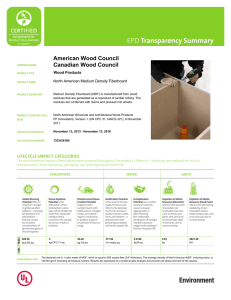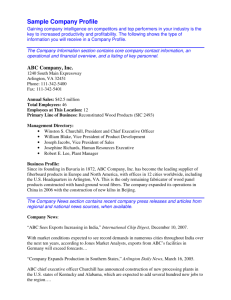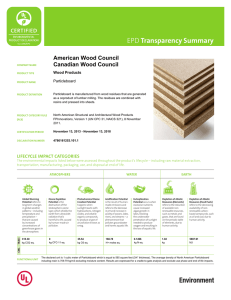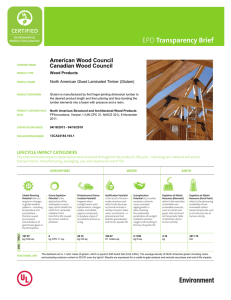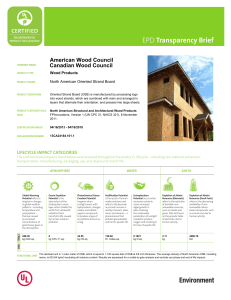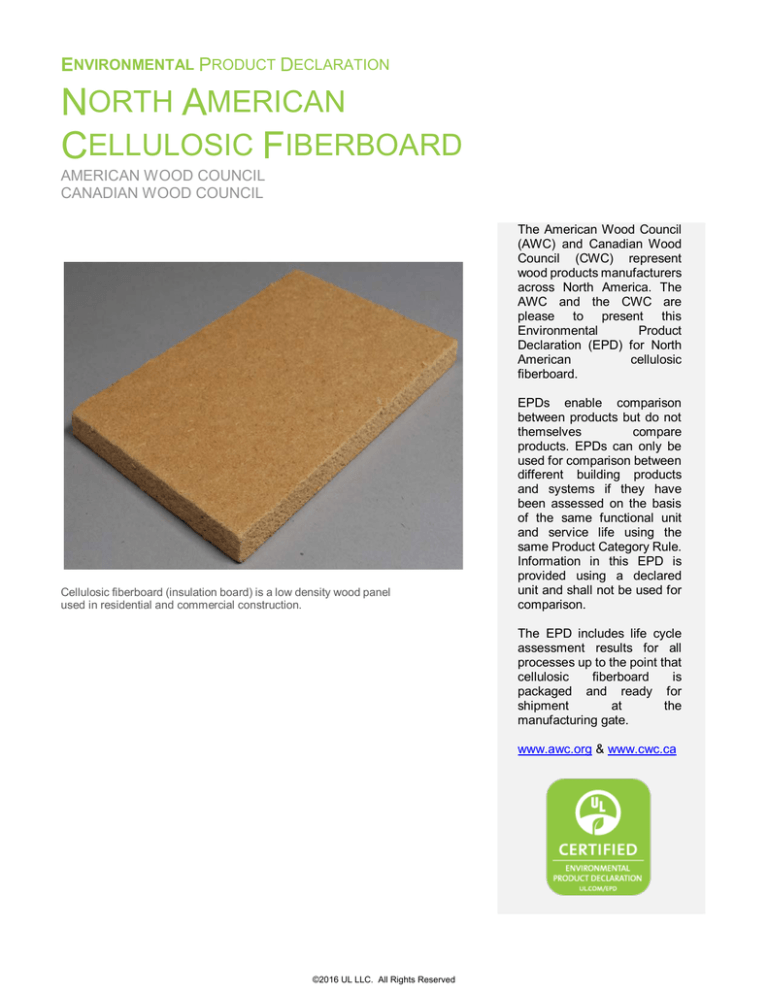
ENVIRONMENTAL PRODUCT DECLARATION
NORTH AMERICAN
CELLULOSIC FIBERBOARD
AMERICAN WOOD COUNCIL
CANADIAN WOOD COUNCIL
The American Wood Council
(AWC) and Canadian Wood
Council (CWC) represent
wood products manufacturers
across North America. The
AWC and the CWC are
please to present this
Environmental
Product
Declaration (EPD) for North
American
cellulosic
fiberboard.
Cellulosic fiberboard (insulation board) is a low density wood panel
used in residential and commercial construction.
EPDs enable comparison
between products but do not
themselves
compare
products. EPDs can only be
used for comparison between
different building products
and systems if they have
been assessed on the basis
of the same functional unit
and service life using the
same Product Category Rule.
Information in this EPD is
provided using a declared
unit and shall not be used for
comparison.
The EPD includes life cycle
assessment results for all
processes up to the point that
cellulosic
fiberboard
is
packaged and ready for
shipment
at
the
manufacturing gate.
www.awc.org & www.cwc.ca
©2016 UL LLC. All Rights Reserved
Page 2 of 18
According to ISO 14025 and ISO 21930
North American Cellulosic Fiberboard (CFB)
North American Structural and Architectural Wood Products
This declaration is an environmental product declaration (EPD) in accordance with ISO 14025. EPDs rely on Life Cycle
Assessment (LCA) to provide information on a number of environmental impacts of products over their
life cycle. Exclusions: EPDs do not indicate that any environmental or social performance benchmarks
are met, and there may be impacts that they do not encompass. LCAs do not typically address the sitespecific environmental impacts of raw material extraction, nor are they meant to assess human health
toxicity. EPDs can complement but cannot replace tools and certifications that are designed to address
these impacts and/or set performance thresholds – e.g. Type 1 certifications, health assessments and
declarations, environmental impact assessments, etc. Accuracy of Results: EPDs regularly rely on
estimations of impacts, and the level of accuracy in estimation of effect differs for any particular product
line and reported impact. Comparability: EPDs are not comparative assertions and are either not comparable or have
limited comparability when they cover different life cycle stages, are based on different product category rules or are
missing relevant environmental impacts. EPDs from different programs may not be comparable.
PROGRAM OPERATOR
DECLARATION HOLDER
DECLARATION NUMBER
UL Environment
American Wood Council
4787319688.101.1
DECLARED PRODUCT
REFERENCE PCR
Cellulosic Fiberboard
FP Innovations. 2015. Product Category Rules (PCR) for preparing and environmental
Product Declaration (EPD) for North American Structural and Architectural Wood
Products. https://fpinnovations.ca/ResearchProgram/environment- sustainability/epdprogram/Documents/pcr-v2.pdf.
February 24, 2016
5 Years
Product definition and information about building physics
DATE OF ISSUE
PERIOD OF VALIDITY
CONTENTS
OF
DECLARATION
Information about basic material and the material’s origin
Description of the product’s manufacture
THE
Indication of product processing
Information about the in-use conditions
Life cycle assessment results
Testing results and verifications
FP Innovations
PCR review committee
info@fpinnovations.ca
The PCR review was conducted by:
This declaration was independently verified in accordance with ISO
14025 by Underwriters Laboratories
☐ INTERNAL
☒ EXTERNAL
This life cycle assessment was independently verified in accordance
with ISO 14044 and the reference PCR by:
Wade Stout, UL Environment
Thomas Gloria, Industrial Ecology Consultants
©2016 UL LLC. All Rights Reserved
Page 3 of 18
North American Cellulosic Fiberboard (CFB)
North American Structural and Architectural Wood Products
According to ISO 14025 and ISO 21930
Description of Industry and Product
Description of North American Cellulosic Fiberboard (CFB) Industry
The North American forest products industry is a major contributor to both the United States and Canadian economies.
Wood manufacturing jobs, including those required to produce cellulosic fiberboard (CFB) serve as the primary economic
drivers in rural areas of both countries. In 2012, CFB production in North America was 702 million ft2, 0.5 – inch basis
(828 thousand m3).
North American CFB is used in residential and commercial construction. Various uses and applications for fiberboard
include: 1. Sound-deadening board, 2. Structural sheathing, and 3. Roofing substrate (i.e., roof fiberboard). Asphalt is
used internally as a binder to improve strength properties and externally as a coating. Coating of CFB is not part of this
EPD. CFB is a panel product developed to utilize industrial wood residue. Wood residues originate from industrial wood
waste such as shavings, sawdust, and chips produced during other wood manufacturing processes and from underutilized whole trees. Additional feedstock sources include mixed paper and construction wood waste.
Manufacturers of CFB in North American are members of the North American Fiberboard Association, Rolling Meadows,
Illinois. Seven CFB manufacturers contributed production data from the United States and Canada. No CFB
manufacturers were in operation in Mexico (Table 1).
Table 1. North American Cellulosic Fiberboard Manufacturers (2012)
Manufacturer
City
State/Province, Country
Temple-Inland Forest Products
Diboll
Texas, United States
Georgia Pacific
Jarratt
Virginia, United States
Blue Ridge Fiberboard
Danville
Virginia, United States
Western Louisville Fiberboard
Calgary
Alberta, Canada
Louisville Specialty Products
Louisville
Québec, Canada
International Bildrite Inc.
International Falls
Minnesota, United States
Building Products of Canada
LaSalle
Québec, Canada
©2016 UL LLC. All Rights Reserved
Page 4 of 18
North American Cellulosic Fiberboard (CFB)
North American Structural and Architectural Wood Products
According to ISO 14025 and ISO 21930
Description of Cellulosic Fiberboard Product
Cellulosic fiberboard falls into the North American Industry Classification System (NAICS) Code 321219, reconstituted
wood products. Over the last several decades, CFB has evolved into a highly engineered product designed to meet
specific end-use requirements. The most common dimensions of CFB panels are 0.5 inch (12.7 mm) thick, 4.0 feet (1.22
m) wide and 8.0 (2.44 m) long. However thickness, width, and length can vary to meet end-use requirements.
The product profile presented in this EPD is for a declared unit of 1 cubic meter of CFB. One cubic meter of average
North American CFB weighs 254 kg excluding moisture. The product composition is presented below and represents
the weighted average of the wood fiber and additives used in CFB manufacturing.
−
−
−
−
−
−
−
Wood: oven dry 234.48 kg (92.22%)
Asphalt flake: 9.61 kg (3.78%)
Starch: 3.84 kg (1.51%)
Wax: 2.83 kg (1.11%)
Clay: 1.51 kg (0.59%)
Alum: 1.44 (0.57%)
Other: 0.55 kg (0.22%)
This EPD is based on LCA studies that considered the entire range of CFB product sizes and functions. For reference
purposes the results are provided for 1 cubic meter of finished product, which is equal to 35.31 cubic feet.
©2016 UL LLC. All Rights Reserved
Page 5 of 18
North American Cellulosic Fiberboard (CFB)
North American Structural and Architectural Wood Products
Cradle-to-Gate Life Cycle of Cellulosic Fiberboard Production
Figure 1 Cradle-to-gate system boundary for cellulosic fiberboard
©2016 UL LLC. All Rights Reserved
According to ISO 14025 and ISO 21930
Page 6 of 18
North American Cellulosic Fiberboard (CFB)
North American Structural and Architectural Wood Products
According to ISO 14025 and ISO 21930
Forest Operations
The PCR requires that the production system include extraction of raw materials including reforestation activities.
Therefore, the life cycle assessment of a wood product includes the energy use and emissions from all forestry
operations which include plantation establishment, management, and harvesting. In the EPD for cellulosic fiberboard,
the cradle-to-gate product system begins with the establishment of a natural or managed forest by natural regeneration
or planting of seedlings, respectively. The boundary also encompasses all forest management activities which may
include site preparation, thinning, and fertilization.
Cellulosic Fiberboard Production
The manufacturing process of CFB begins with processing wood residues to produce a homogeneous feedstock. The
prepared feedstock is refined by mechanically reducing and thermally softening the material into fibers. The fibers are
then washed and mixed with water and additives to create a fiber slurry. No resins are added to produce CFB. A thermomechanical process reduces the wood fibers and binds them with a starch for recombination into CFB. Other additives
may include alum, clay, and wax. Asphalt can also be added in the mix to improve strength properties. Adding water to
the fiber creates a slurry that is then transformed into a fiber mat. The wet mats have a moisture content of 65-75 percent
before drying. Presses and large dryers are used to remove water resulting in a final moisture content of CFB of about
4 percent. Boards are trimmed to dimension and packaged for shipment.
Packaging of Cellulosic Fiberboard
Packaging materials represent less than 1.0 percent of the cumulative mass of the model flow. Wrapping material can
vary between products and manufacturer. Cellulosic fiberboard sheets are dead-stacked on pallets and wrapped using
polyethylene laminated paper. For shipping, there can up to 80 CFB (1/2”) sheets wrapped to together on a single pallet
(unit). A total of 20 units are shipped on flat-bed trucks. Wood spacers are used between units. Pallet production and
transportation of packaged CFB are excluded from this EPD.
©2016 UL LLC. All Rights Reserved
Page 7 of 18
North American Cellulosic Fiberboard (CFB)
North American Structural and Architectural Wood Products
According to ISO 14025 and ISO 21930
Methodology of Underlying LCA
Business-to-business EPD and Cradle-to-Gate LCA
Business-to-business (B-to-B) EPDs include the life cycle of the product up to the point that the product has been
manufactured and is ready for shipment. This is commonly referred to as a cradle-to-gate life cycle assessment. The
cradle-to-gate processes included in this EPD are outlined in Figure 1. The use phase and end of life scenarios can be
omitted in a B-to-B EPD.
This Type III environmental declaration is developed according to ISO 21930 and 14025 for cellulosic fiberboard. This
EPD reports environmental impacts based on established life cycle impact assessment methods. The reported
environmental impacts are estimates, and their level of accuracy may differ for a particular product line and reported
impact. LCAs do not generally address site-specific environmental issues of related to resource extraction or toxic effects
of products on human health. Unreported environmental impacts include (but are not limited to) factors attributable to
human health, land use change and habitat destruction. Forest certification systems and government regulations address
some of these issues. In this EPD the woody residues used in the production of CFB coming from Canadian and US
forests are harvested under the applicable federal, provincial, and state laws. EPDs do not report product environmental
performance against any benchmark.
Declared Unit
In accordance with the PCR, the declared unit for CFB is one cubic meter (m3) which is equal to 35.31 cubic feet. The
average density of North American CFB including additives is 254 kg/m3 oven dry. Cellulosic fiberboard produced in
North America has a moisture content of 4 percent at the plant gate when it is ready for shipment. Moisture content of
CFB is quite stable due to the high temperatures used during the manufacturing process.
System Boundaries
The system boundary begins with the planting, growth and harvest of trees in North American and ends with CFB
packaged to leave the mill gate. The forest resources system boundary includes: forest regeneration and stand
management, felling the trees, removing limbs, transportation of logs to landing, and cutting to shipping lengths as
needed. Excluded from forestry operations are maintenance and repair of equipment, and building and maintenance of
logging roads, logging camps, and weigh stations. The transportation of logs from the woods to the mill is accounted for
with the CFB manufacturing. Cellulosic fiberboard production includes feedstock collection, storage (wood residues,
logs, construction waste, and paper), processing, and packaging. Outputs include 1 m3 of CFB ready to be shipped, air
and water emissions, solid waste, and co-products.
©2016 UL LLC. All Rights Reserved
Page 8 of 18
North American Cellulosic Fiberboard (CFB)
North American Structural and Architectural Wood Products
According to ISO 14025 and ISO 21930
Cut-Off rules
The cut-off criteria for flows to be considered within the system boundary are as follows:
−
Mass – if a flow is less than 1% of the cumulative mass of the model flows, it may be excluded, provided its
environmental relevance is minor.
−
Energy – if a flow is less than 1% of the cumulative energy of the model flows, it may be excluded, provided its
environmental relevance is minor.
−
Environmental relevance – if a flow meets the above two criteria, but is determined (via secondary data analysis) to
contribute 2% or more to the selected impact categories of the products underlying the EPD, it is included within the
system boundary.
©2016 UL LLC. All Rights Reserved
Page 9 of 18
North American Cellulosic Fiberboard (CFB)
North American Structural and Architectural Wood Products
According to ISO 14025 and ISO 21930
Data Quality
Precision and Completeness
Primary data on raw materials, energy, and emissions were provided by CFB manufacturing facilities based on purchase
inputs, production outputs, and reported process emissions. All upstream and downstream secondary data (e.g. forestry
operations and fuel production) were drawn from publicly available databases, primarily the United States Life Cycle
Inventory (USLCI) database and other public LCI data sources. The LCA practitioners performed quality control on all
secondary data sources to ensure completeness.
All inventory flows were modeled and no data were excluded due to application of the EPD cut-off criteria.
Consistency and Reproducibility
To ensure consistency only primary data, as provided by the CFB manufacturers, were used to model gate-to-gate CFB
manufacturing processes. All other secondary data (upstream and downstream) were consistently applied and
adaptations to the databases were documented in the LCA reports.
Reproducibility by third parties is possible using the background LCIs documented in the CORRIM and Athena reports.
Temporal Coverage
Primary data collected from the manufacturing facilities related to the product processes of interest are representative
for the year 2012.
Geographic Coverage
The geographical coverage for this EPD is based on North American (NA) system boundaries for all processes and
products.
Treatment of Biogenic Carbon
Biogenic carbon dioxide emissions were accounted as global warming neutral in accordance with the PCR. Under this
approach, the carbon dioxide emissions from the combustion of internally generated wood fuels are considered equal to
the carbon dioxide uptake in the forest during tree growth.
Crediting carbon sequestration against the global warming potential was excluded as the long term carbon storage is
dependent on gate-to-grave processes not considered directly in this EPD. The expected carbon sequestration for
average end-use and end-of-life treatment is provided in the section on “Additional Information.”
©2016 UL LLC. All Rights Reserved
Page 10 of 18
North American Cellulosic Fiberboard (CFB)
North American Structural and Architectural Wood Products
According to ISO 14025 and ISO 21930
Allocation
According to the PCR (FPInnovations 2015) if one or more co-products are generated during the production process, it
is necessary to allocate the inputs and outputs using a standardized approach. The LCA on CFB follows the allocation
rules which states that when the total revenues between the main product and co-products is more than 10%, allocation
shall be based on the revenue [economic] allocation. A no allocation method was applied to CFB. An economic allocation
was applied to upstream wood residue production.
Data Collection and Calculation Methods
Primary data for the LCI was collected through surveys. This study relied almost exclusively on production inputs and
emissions data provided by CFB producers in North America, with some secondary data from the USLCI database. A
no allocation approach was applied therefore all inputs and outputs into the CFB manufacturing process were allocated
to CFB (main product). Survey data were converted to a unit production basis of 1 cubic meter and a weighted average
of input data was calculated based on production data.
©2016 UL LLC. All Rights Reserved
Page 11 of 18
North American Cellulosic Fiberboard (CFB)
North American Structural and Architectural Wood Products
According to ISO 14025 and ISO 21930
Life Cycle Assessment Results
The life cycle impact assessment (LCIA) established links between the life cycle inventory results and the potential
environmental impacts. In the LCIA, results are calculated for impact category indicators such as global warming
potential and smog potential. These impact category indicator results provide general, but quantifiable, indications of
potential environmental impacts. Consistent with the requirements of the PCR, five impact categories are reported in
Table 2. The TRACI 2 method was used to characterize the reported environmental impacts.
Table 2: Impact Assessment Categories
Impact Category Indicators
Characterization Model
Global
Warming
Potential
Calculates global warming potential of all greenhouse gasses that are
recognized by the IPCC. The characterization model scales substances that
include methane and nitrous oxide to the common unit of kg CO2
equivalents.
Ozone
Depletion
Potential
Calculates potential impact of all substances that contribute to stratospheric
ozone depletion. The characterization model scales substances that include
CFC’s, HCFC’s, chlorine, and bromine to the common unit of CFC-11
equivalents.
Acidification
Potential
Calculates potential impacts of all substances that contribute to terrestrial
acidification. The characterization model scales substances that include
sulfur oxides, nitrogen oxides, and ammonia to the common unit of kg SO2
equivalents.
Smog
Potential
Calculates potential impacts of all substances that contribute to
photochemical smog. The characterization model scales substances that
include nitrogen oxides and volatile organic compounds to the common unit
of kg O3 equivalents.
Eutrophication
Potential
Calculates potential impacts of all substances that contribute to
eutrophication. The characterization model scales substances that include
nitrates and phosphates to the common unit of kg N equivalents.
©2016 UL LLC. All Rights Reserved
Page 12 of 18
North American Cellulosic Fiberboard (CFB)
North American Structural and Architectural Wood Products
According to ISO 14025 and ISO 21930
Cradle-to-Gate Impact Assessment
Modules included in the EPD are (Table 3): A1- Raw material supply, which includes resource extraction and residue
production processes, A2 – Transportation of resource to residue production or residues to CFB, and A3 – Cellulosic
fiberboard production. The impact assessment results for CFB are shown in Table 4. This LCIA does not make value
judgments about the impact indicators, meaning that no single indicator is given more or less value than any of the
others. All are presented as equals. Each impact indicator summarizes a different group of environmental emissions
based on their pathway to potential impact using reference units that are common to the group but not comparable
between the groups. For this reason the indicators should not be combined or added.
The results presented below indicate the potential impacts caused by the cradle-to-gate production of CFB. Ozone
depletion was below 10-5 kg CFC eq. for forestry operations, residue production, and CFB production and is thus not
reported in the results. Water consumption was a total from the LCI as required by the PCR and includes all water
withdrawals without netting out non-consumptive use. As a result, the total water consumption is a conservative value
which may overstate the use.
Table 3. Life cycle stages included in the LCA.
Construction
process
Stage
Benefits and loads
beyond the system
boundary
Manufacturing
Transport from the
gate to the site
Assembly
Use
Maintenance
Repair
Replacement
Refurbishment
Operational energy
use
Operational water
use
De-construction
demolition
Transport
Waste processing
Disposal
ReuseRecoveryRecyclingpotential
End of life stage
Transport
Use stage
Raw material
supply
Product stage
A1
A2
A3
A4
A5
B1
B2
B3
B4
B5
B6
B7
C1
C2
C3
C4
D
X
X
X MND MND MND MND MND MND MND MND MND MND MND MND MND
X = modules included in the study
MND = Module not declared
©2016 UL LLC. All Rights Reserved
MND
Page 13 of 18
North American Cellulosic Fiberboard (CFB)
North American Structural and Architectural Wood Products
According to ISO 14025 and ISO 21930
Table 4: Cradle-to-Gate Impact Assessment Results - 1 m3 North American Cellulosic Fiberboard
Impact category Indicator
Unit
Total
Forestry
operations
Wood
residue
production
CFB
Production
Global warming potential
kg CO2 eq.
295.0548
3.2387
10.5869
281.2292
Acidification Potential
kg SO2 eq.
2.9207
0.0439
0.0912
2.7856
Eutrophication Potential
kg N eq.
0.0712
0.0069
0.0063
0.0580
Ozone depletion Potential
kg CFC-11 eq.
0.0
0.0000
0.0000
0.0000
Smog Potential
kg O3 eq.
20.6424
1.2793
17.5369
Unit
Total
Forestry
operations
1.8262
Wood
residue
production
Total primary energy
consumption
MJ
6,148.23
50.04
198.75
5,899.44
Non-renewable, fossil
MJ
4,395.48
49.49
161.71
4,184.28
Non-renewable, nuclear
MJ
442.95
0.49
18.32
424.14
Renewable, biomass
MJ
1,018.29
0.00
10.07
1,008.22
Renewable, other
MJ
291.51
0.06
282.80
Material resources
consumption
Unit
Total
Forestry
operations
8.65
Wood
residue
production
Non-renewable materials
kg
0.3173
0.0000
0.0013
0.3160
Renewable materials
kg
333.208
186.194
145.590
1.424
Fresh water
L
3,795.78
0.63
6.68
Wood
residue
production
3,788.47
0.65
56.28
Non-hazardous waste
generated
Unit
Total
Forestry
operations
Solid waste
kg
56.98
0.05
©2016 UL LLC. All Rights Reserved
CFB
Production
CFB
Production
CFB
Production
Page 14 of 18
North American Cellulosic Fiberboard (CFB)
North American Structural and Architectural Wood Products
According to ISO 14025 and ISO 21930
Impact Assessment Results by Life Stage
Figures 2 and 3 show the CFB manufacturing life cycle stage is the primary driver of impacts in the cumulative cradleto-grave product system. Cellulosic fiberboard manufacturing consumes 92% of fossil fuels and 96% of biomass energy
which drives the impacts in all categories.
Figure 2: Cradle-to-Gate Impact Assessment Results
100%
90%
80%
70%
60%
50%
40%
30%
20%
10%
0%
Global warming
Forestry Operations
Acidification
Eutrophication
Wood Residue Production
Smog
Cellulosic Fiberboard Production
Figure 3: Cradle-to-Gate Primary Energy Consumption
100%
90%
80%
70%
60%
50%
40%
30%
20%
10%
0%
Non-renewable fossil
Forestry Operations
Non-renewable nuclear
Renewable, biomass
Wood Residue Production
Renewable, other
Cellulosic Fiberboard Production
©2016 UL LLC. All Rights Reserved
Page 15 of 18
North American Cellulosic Fiberboard (CFB)
North American Structural and Architectural Wood Products
According to ISO 14025 and ISO 21930
Primary Energy Consumption by Resource
Figures 4 through 7 show the primary energy consumption by type for the total cradle-to-gate, forestry operations,
residue production, and CFB production life stages respectively. The CFB production consumes the bulk of the energy
consumption and is reflected in the total cradle-to-gate chart (Figure 4).
The forestry operations portion of the life cycle relies heavily on oil-based energy consumed mainly in the form of diesel
used by heavy equipment during planting, management, and harvesting of the resource. Oil accounts for 79 percent of
primary energy resources consumed in forestry operations, followed by natural gas making up most of the rest at 17
percent (Figure 5).
The majority of the total cradle-to-gate biomass fuel, 81 percent, is consumed during CFB production. Wood residues
are the primary fuel used in production of wood residues representing 40 percent of the total energy. Wood residue are
generated during the production of products such as lumber and plywood, it is used to replace the use of fossil fuels for
heat generation (Figure 6).
While the majority of the biomass fuel is used during cellulosic fiberbaord production, fossil fuels remain they main energy
source. Very little wood waste is generated during the production of CFB which makes using wood waste as a fuel
source difficult. Around 17 percent of the total energy comes from biomass with over half from fossil fuels. Coal is used
directly in boilers during CFB production, representing 27 percent of the total energy. Hydopower use is approximately
5 percent and is from electricity that is consumed throughout the cradle-to-gate production system (Figure 7).
The cradle-to-gate renewable biomass energy use in the life cycle of CFB reduces the energy consumption derived from
fossil fuel sources by 19 percent which results in a lower overall carbon footprint.
Figure 4 Cradle-to-Gate Energy Use
Figure 5 Forestry Operations Energy Use
Coal: 27%
Natural gas: 38%
Oil: 7%
Uranium: 7%
Wood: 17%
Other: 5%
©2016 UL LLC. All Rights Reserved
Coal: 3%
Natural gas: 17%
Oil: 79%
Uranium:1%
Wood: 0%
Other: 0%
Page 16 of 18
North American Cellulosic Fiberboard (CFB)
North American Structural and Architectural Wood Products
Figure 6 Residue Production Energy Use
According to ISO 14025 and ISO 21930
Figure 7 Cellulosic Fiberboard Production
Energy Use
Coal: 25%
Natural gas: 11%
Oil: 43%
Uranium: 10%
Wood: 5%
Other: 5%
©2016 UL LLC. All Rights Reserved
Coal: 27%
Natural gas: 38%
Oil: 6%
Uranium: 7%
Wood: 17%
Other: 5%
Page 17 of 18
North American Cellulosic Fiberboard (CFB)
North American Structural and Architectural Wood Products
According to ISO 14025 and ISO 21930
Additional Information
Range of Applications
Cellulosic fiberboard is primarily used as sound-deadening board, structural sheathing, and roof fiberboard in residential
and commercial construction. It is classified as part of a product group of Cellulosic Fiber Insulating Board and Wood
Fibre Insulating Boards for Building. The carbon sequestration calculation on the following page is based on the expected
service life for CFB. To complete this calculation, the various end used for CFB were estimated based on the
classification for “non-structural panels” as provided in the FPInnovations B-to-B carbon sequestration tool.
The following lists the breakdown of insulating board end uses in North America:
-
New non-residential construction: 30%
Commercial roofing: 30%
New single family residential construction: 5%
New multi-family residential construction: 1%
Other end-uses: 34%
©2016 UL LLC. All Rights Reserved
Page 18 of 18
North American Cellulosic Fiberboard (CFB)
North American Structural and Architectural Wood Products
According to ISO 14025 and ISO 21930
Carbon Sequestration
This PCR requires that carbon sequestration may only be credited to the product if the end-of-life fate of that carbon is
considered in the LCA study. FPInnovations (FPI) has recently published a carbon sequestration calculation tool that
estimates the emissions from typical end-of-life treatment of wood products that includes recycling, combustion, and
landfilling. The carbon sequestration in the product at the manufacturing gate serves as the basis for such an analysis
and is as follows (all conversion factors and assumptions are documented in the carbon tool):
1 m3 Cellulosic Fiberboard = 234.48 oven dry kg = 117 kg Carbon = 429.89 kg CO2 eq.
This initial carbon sequestration may then be considered against its emission as the cellulosice fiberboard product
reaches the end of its service life in various applications. The FPI carbon tool is used to estimate the biogenic carbon
balance at year 100, including service life estimations for various applications and the average landfill decay rate. The
carbon tool gives the following results for nonstructural panels:
Carbon sequestered in product at manufacturing gate:
429.89 kg CO2 eq. = - 429.89 CO2 eq emission
Methane emitted from fugitive landfill gas:
2.00 kg CH4 = 50.00 kg CO2 eq emission
Carbon dioxide emitted from fugitive landfill gas and the combustion of waste and captureed landfill gas:
142.04 kg CO2 eq emission
Carbon sequestration at year 100, net of biogenic carbon emissions:
237.84 kg CO2 eq emission = - 237.84 kg CO2 eq emission
©2016 UL LLC. All Rights Reserved
Page 19 of 18
North American Cellulosic Fiberboard (CFB)
North American Structural and Architectural Wood Products
According to ISO 14025 and ISO 21930
Additional Information
ASTM International. 2012. Standard specification for cellulosic fiber insulating board. American Society for Testing and
Materials. ASTM C208-12. West Conshohocken, PA. 58-61.
Athena: 2012. A cradle to gate life cycle assessment of Canadian oriented strand board: An Update. Athena Sustainable
Materials Institute.
CAN/ULC-S706. 2009. Standard for Wood Fibre Insulating Boards for Building. Second Edition. Underwriters
Laboratories of Canada
CORRIM:2015. Cradle to Gate Life Cycle Assessment of North American Cellulosic Fiberboard Production
FPInnovations. 2015. Product Category Rules (PCR) for preparing and environmental Product Declaration (EPD) for
North American Structural and Architectural Wood Products. https://fpinnovations.ca/ResearchProgram/environmentsustainability/epd-program/Documents/pcr-v2.pdf.
FPInnovations
and
Athena
Institute:
2013.
Business-to-Business
Carbon
Sequestration
Tool
https://fpinnovations.ca/ResearchProgram/environment-sustainability/epd-program/Documents/carbon-tool-user-guide2.18.pdf
ISO 14040:2006. Environmental management - Life cycle assessment–Principles and Guidelines
ISO 14044:2006. Environmental management - Life cycle assessment–Requirements and guidelines
ISO 21930:2007. Building and Construction Assets – Sustainability in building construction – Environmental declaration
of building products.
TRACI 2.0 - Tool for the reduction and assessment of chemical and other environmental impacts.
http://www.epa.gov/ord/NRMRL/std/traci/traci.html
USCB. 2012. 2012 North American Industry Classification System Definitions. 321219 Reconstituted Wood Product
Manufacturing. United States Census Bureau. www.census.gov/eos/www/naics/ accessed July 2015.
USLCI Database: https://www.lcacommons.gov/nrel/search
©2016 UL LLC. All Rights Reserved

